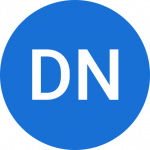So I did what most don’t — I stopped copying desktop tactics and started figuring out what actually works for mobile exit intent popups.
There was no cursor, no clean exit signals, so it was all guesswork. And the popups? They were slow, annoying, and impossible to dismiss. I knew mobile traffic was huge, but I had no clear way to catch users before they bounced.
So I tested. Back taps, fast scrolls, and idle time. I cracked the design, personalized the offer, and ensured it didn’t kill the experience.
That’s when things changed. Conversions up. Complaints down.
This guide is everything I wish someone had told me: exit signals to watch, proven strategies, best practices that engage users, and functional mobile exit intent popup formats.
What Is Mobile Exit Intent (+Why You Need It)
Mobile exit intent is a smart popup that shows up when a visitor is about to leave your website on a mobile device. It detects exit behavior by recognizing touch-based actions, such as tapping the back button or closing the tab. Then, it gives users one last chance to engage, such as signing up for a newsletter or taking advantage of a special offer.
Want to see how it works in real life? Here’s a quick video showing mobile exit intent and how it can help boost your conversions.
Using mobile exit intent can boost your conversion rates, reduce bounce rates, and improve user engagement. The best part is that mobile exit popups are designed to look great on smaller screens, so usability is not a problem.
How to Implement Mobile Exit Intent Popups: Best Practices and Examples
You can follow plenty of tips and best practices to ensure your mobile exit intent popup campaigns hit the mark. Here are five tips for designing effective mobile exit intent popups, along with examples and common mistakes to avoid:
1. Be Clear and Concise
When it comes to designing mobile exit intent popups, clarity and simplicity are key. Make sure your message is clear and easy to understand. The user should be able to grasp what your popup is offering immediately and why they should engage with it. Avoid jargon or technical terms that might confuse the user, and keep the message short and to the point.
Example: This popup delivers a clear, time-sensitive offer — free shipping on everything for three days. It keeps the message action-focused and straightforward with bold text, minimal clutter, and a direct CTA.
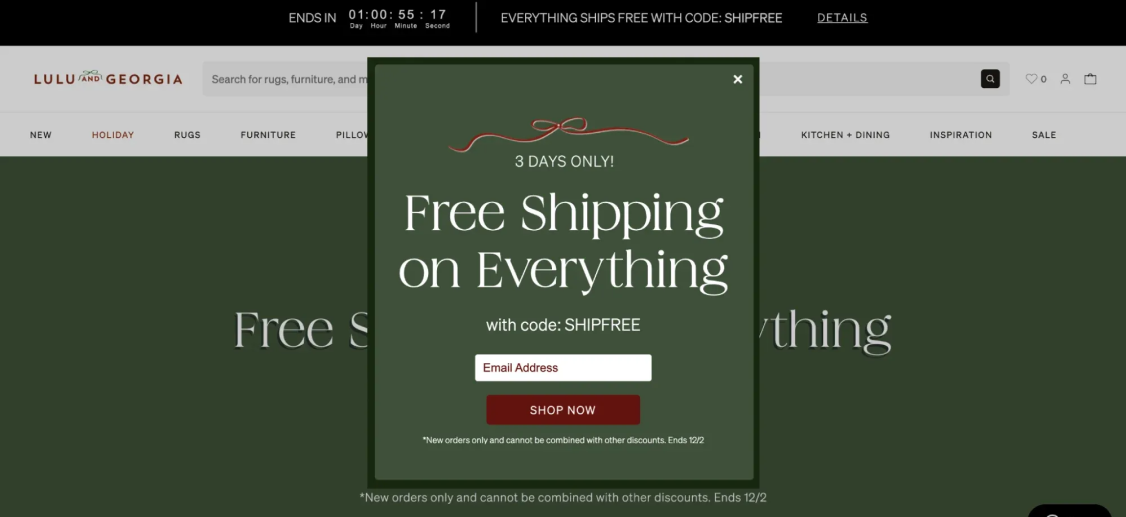
Mistakes to avoid: Don’t make the message too long or complicated, and avoid using jargon or technical terms that might confuse the user.
2. Offer Something of Value
Offering users something of value is an effective way to entice them to engage with your exit intent popup on mobile. People are more likely to take action when they feel they are getting something in return.
For example, if you run an e-commerce store, you might offer a discount code for first-time customers who sign up for your email list. This gives users an immediate incentive to engage with your popup and purchase. Similarly, if you run a software company, you might offer a free product trial to users who sign up for a demo.
Example: This popup from Sienna Sauce highlights a clear value exchange—a free cookbook and exclusive recipes for joining their E-Club. It appeals directly to the user’s interest and gives them a tangible reason to share their email and complete the purchase.
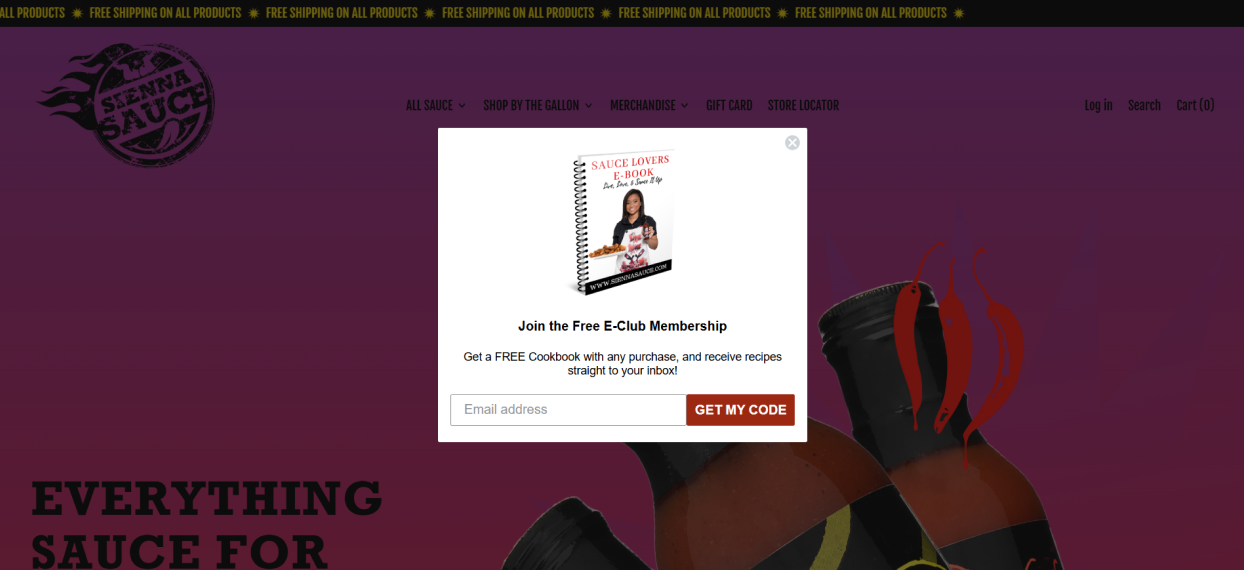
Mistakes to avoid: Don’t offer something that isn’t actually valuable to your audience, or make the offer too complicated to redeem.
3. Use Eye-Catching Visuals
To capture the user’s attention, it’s important to design an exit intent popup on mobile that is visually appealing and consistent with your brand identity.
Start by choosing colors, fonts, and imagery consistent with your brand identity. This will help ensure your popup feels like a natural extension of your website rather than a jarring interruption. Use bold, contrasting colors that stand out against the rest of your website to draw the user’s eye.
Consider using imagery relevant to the message you are trying to convey, such as product photos or illustrations.
Example: This exit intent popup for mobile grabs attention instantly with its bold, close-up image of a juicy sandwich and dark contrasting background. It uses strong visuals and playful copy to stop users mid-exit and guide them back to checkout. The CTA and imagery work together to drive action in a fun, brand-consistent way.

Mistakes to avoid: Avoid using images or colors that are off-brand or distracting, and avoid using too many design elements that can make the popup cluttered or overwhelming.
4. Personalize the Message
By tailoring your mobile exit intent popup message based on the user’s behavior or interests, you can increase the chances that they will engage with the popup and take action.
There are a few ways to personalize your mobile exit intent popup message. You can use data that you already have about the user, such as their location, browsing history, or past purchases. For example, if you run an e-commerce store, you could use information about the user’s past purchases to suggest complementary products or offer a personalized discount code.
Example: Sunbasket’s exit intent popup for mobile delivers a strong, personalized message by highlighting exactly what the user values—savings and convenience. With a tailored offer of $90 off across four boxes plus free shipping, it speaks directly to price-sensitive, first-time buyers. This animated popup increases the chances of re-engagement.
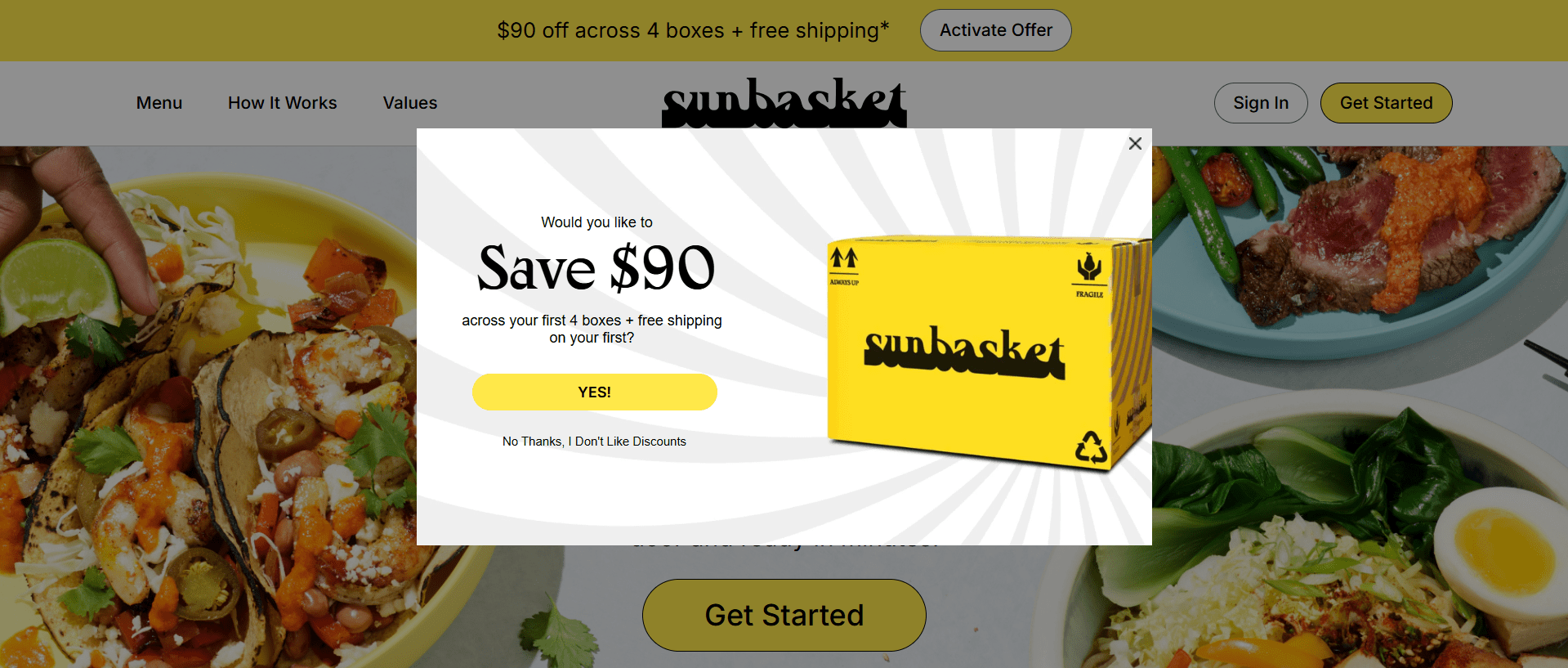
Mistakes to avoid: Don’t use personalization in a way that feels intrusive or creepy, and make sure the message is still relevant to the user’s needs and interests.
5. Test and optimize
Testing and optimization are essential for making sure that your mobile exit intent popups are as effective as possible.
Start by setting clear goals for your mobile exit intent popup. What action do you want the user to take when they see the popup?
Next, create multiple versions of your popup with different designs, messages, and offers. Test these versions against each other using A/B testing or multivariate testing, and gather data on which version performs best in terms of conversions and engagement.
Once you have identified a winning version, continue to test and optimize it over time. Try different variations of the winning design or message and look for opportunities to improve the user experience or increase the value of the offer.
Example: The exit popup from TOMS is a strong example of clean, user-first design. It pairs a clear 15% discount with a simple layout and optional interest selection. By allowing users to self-segment, TOMS gathers valuable data without adding friction. They test and optimize for behavior and engagement to drive conversions.
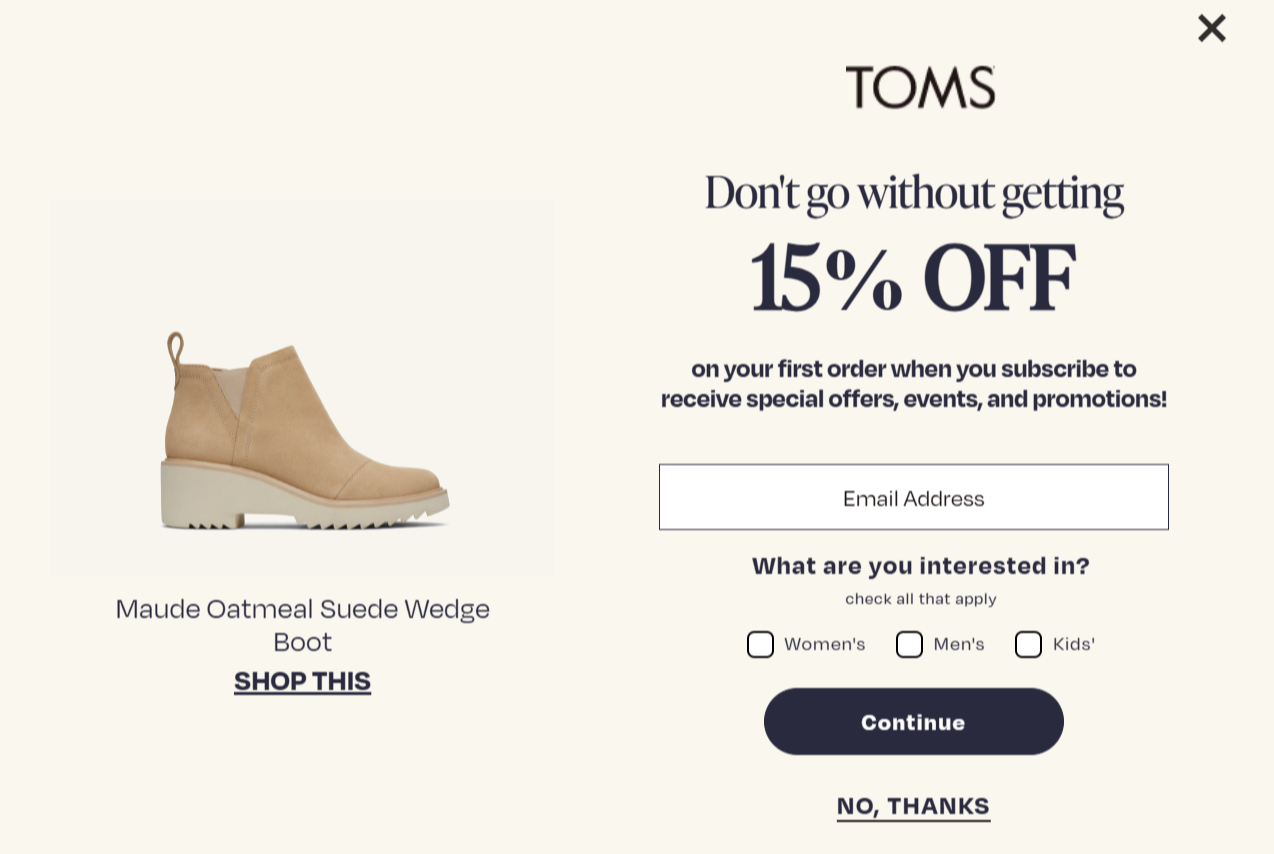
Mistakes to avoid: Don’t assume that your first design or message is the best one, and don’t stop testing and optimizing just because you see some initial success. Continuously monitor and improve your mobile exit intent popups to keep seeing results.
Read More - 36 Winning Exit Intent Popup Examples to Boost Website Conversions
How to Optimize Your Mobile Exit Intent Strategy
Are you tired of losing valuable website visitors? If so, then it’s time to start optimizing your mobile exit intent strategy with analytics and A/B testing. By using these tools, you can identify what’s working and what’s not and make the necessary adjustments to keep your visitors engaged and converting.
Are you tired of losing valuable website visitors? Here are a few strategies you must adopt to convert the maximum number of visitors:
1. Master Mobile-Specific Triggers
Mobile exit intent isn’t as straightforward as on desktop, as there’s no mouse movement to track. Instead, you’re looking at behaviors like quick upward scrolling, back button taps, or even pauses in activity. These are your cues that a user might be about to leave.
That’s when smart triggers like scroll depth (around 50%), short delays, or detecting inactivity can help you step in with a well-timed offer. Tools like Picreel also offer these mobile-specific triggers, making delivering discounts, reminders, or freebies easier before users exit, without disrupting their experience.
Here are a few popup triggers that Picreel offers:

2. Personalization: Make Every Popup Feel Relevant
Mobile users are just a tap away from leaving, so make your popup count by tailoring it to their journey. Use behavior-based targeting to show offers tied to what they’ve browsed, like a discount on a product they viewed or a cart abandonment reminder.
Add dynamic personalization using their name or location to make it feel relevant in the moment. Instead of simply saying “Don’t go,” offer real value that catches their attention. A time-sensitive coupon or a fun chance to win something can give them a compelling reason to stick around.
Here’s a quick personalized popup example I have made using Picreel.
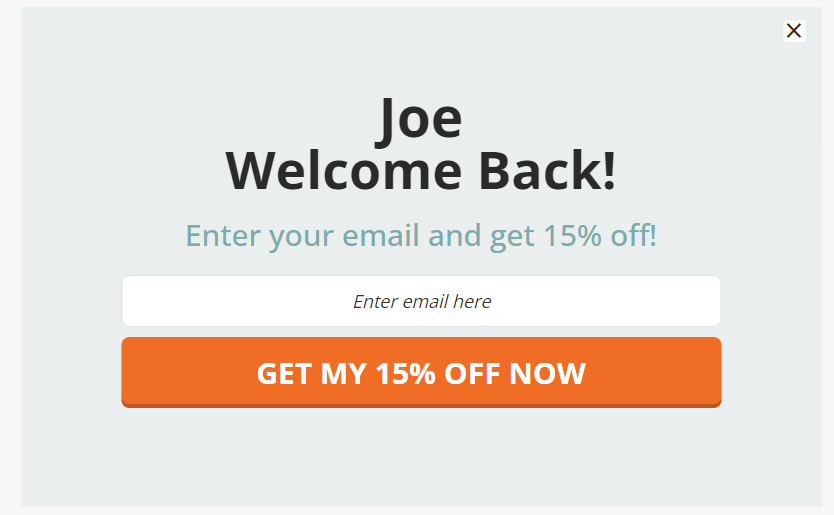
3. Leverage Marketing Automation With CRM
Integrating your mobile exit intent popups with a CRM like BIGContacts helps you stay connected with visitors, even after they leave. If someone closes a popup without taking action, you can automatically send a follow-up email with a discount or reminder.
You can also match popup offers with ongoing email promotions or social ads, so your message feels consistent and relevant. Such intelligent automation keeps your brand in front of potential customers, giving them more chances to return and convert.
If you are new to email marketing automation, here’s how you can do it:

4. Design for Mobile Usability and Speed
When designing exit intent popups for mobile, the key is to keep things fast, simple, and effortless. Mobile users scroll quickly and have little patience for anything that slows them down or clutters the screen. A clean, vertical mobile website popup layout that loads instantly and fits naturally into the mobile experience makes a huge difference.
Keep your message brief to avoid frustration, use large, easy-to-tap buttons, and always include a visible close option. Instead of full-screen takeovers, consider lighter formats like sticky bars or small banners that feel less intrusive and more user-friendly.
Here’s an example of a clean, fast-loading mobile exit intent popup I created using Picreel to give you some design inspiration.
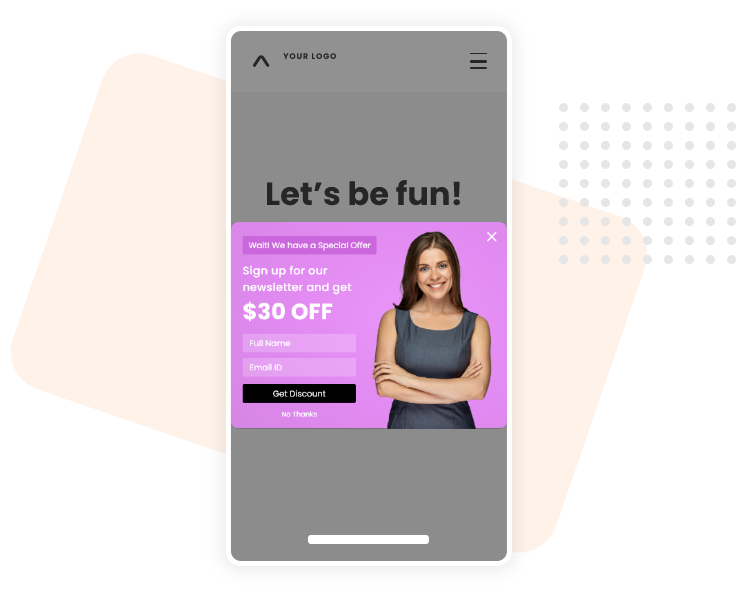
5. Track Performance With Integrated Analytics
To make your mobile exit intent popups truly work, you’ve got to monitor the numbers. Start with key metrics like conversion rate, bounce rate, and time on site. These give you insight into what’s working and what needs tweaking.
Here’s a video tutorial of how you can track your popup performance with Picreel’s analytics:
Make sure to track these stats to keep improving and getting better results over time:
| Metrics | Fix |
|---|---|
| Low conversions | Try refining your message or CTA |
| High bounce rates | Adjust when or where the popup shows |
| Low On-Page Time | Tweak your design or content |
6. Ensure GDPR Compliance and Data Privacy
The GDPR regulation necessitates that any form of data collection, including via popups, must be accompanied by clear, informed consent from the user. You can even use cookie popups to inform users about tracking and allow them to manage preferences.
Make sure your popup clearly explains why you’re collecting data and how it’ll be used, especially if you’re offering a lead magnet or discount. Always include consent checkboxes and a link to your privacy policy.
Here’s how it should look:

Following GDPR regulations and being upfront not only keeps you compliant, but it also builds credibility and encourages more people to engage.
5 Popular Exit Intent Popups for Mobile
One way to optimize your mobile website’s conversion rate is by implementing exit intent popups. These popups are triggered when a user is about to leave your website and can offer them a last-minute incentive to stay or convert. But which type of exit intent popup is right for your mobile website?
Here are a few options to explore:
- Overlay Popups: Overlay popups are the most common type of exit intent mobile popup. They appear as a small box or banner overlapping the website’s content. Overlay popups can be used to promote a discount or offer, encourage users to subscribe to a newsletter, or invite them to follow on social media.

- Full-Screen Popups: Full-screen popups take up the entire screen, blocking out the website’s content entirely. They can be used to offer a more engaging and immersive experience, such as a video or interactive quiz. However, be cautious when using full-screen popups, as they can be intrusive and potentially turn off some users.
- Gamified Popups: Gamified popups are designed to make an exit-intent experience more fun and interactive. They often include games, challenges, or quizzes that reward the user for staying on the website or completing a certain action. Gamified popups can be a great way to increase engagement and make an exit-intent experience more enjoyable.

- Countdown Timer Popups: Countdown timer popups create a sense of urgency by displaying a countdown clock that indicates the time remaining to take advantage of a special offer or promotion. These popups can effectively encourage users to take action before time runs out.

- Survey Popups: An exit survey popup is a small window that appears when a visitor is about to leave your website, prompting them to share feedback before they go. It helps capture valuable insights on user experience, reasons for exit, and areas for improvement, boosting retention and optimizing your site’s performance.
FREE. All Features. FOREVER!
Try our Forever FREE account with all premium features!
Is Exit Intent Popup Effective on Mobile?
Exit intent popups have been a popular tool for increasing website conversions for years, but how effective are they on mobile devices?
1. The Pros and Cons of Using Exit Popups on Mobile Devices
Exit popups can be effective on mobile devices, but there are pros and cons to consider.
Pro: Mobile exit popups offer a final opportunity to engage distracted users and boost conversions before they leave the page.
Con: They can be intrusive on small screens, potentially frustrating users and slowing down page load times.
2. Best Practices for Using Exit Popups Effectively
If you do decide to use attractive exit intent popups (mobile), follow these best practices:
- Ensure popups are mobile-friendly and optimized for small screens.
- Use clear, concise language with a strong call to action.
- Make popups easy to close and avoid covering too much of the screen.
- Trigger exit popups like cart abandonment overlays at the right time, such as after time spent or scroll depth.
- Avoid displaying popups too quickly to prevent a negative user experience.
3. Alternatives to Exit Popups on Mobile Devices
If you’re not convinced that exit popups are the right choice for your mobile website, consider these options:
- On-site messaging: Displays messages directly on the webpage for a seamless, non-intrusive user experience.
- Retargeting ads: Serve ads to users after they leave your site on other websites or social media platforms, encouraging them to return.
Exit With a Bang: Boost Your Mobile Conversions With Exit Intent Popups
Mobile exit intent popups can be a highly effective way to maximize conversions and retain users on your website. You can optimize your exit intent strategy and achieve better results by implementing the best practices discussed in this article, such as personalization, A/B testing, and analytics tracking.
Remember to always prioritize user experience and offer valuable incentives to encourage engagement. With the right approach and attention to detail, exit intent mobile popups can be a powerful tool for driving conversions and growing your business.
Popup builder Tools like Picreel can also be very handy. They offer superior popup-building capabilities for desktop and mobile. The tool also provides a forever-free plan so you can try it out before committing.
Frequently Asked Questions
Can mobile exit intent popups be used to gather user feedback?
Yes, you can use them to ask short questions or run quick surveys as users leave, which will help you understand their experience and improve your site.
Are there any SEO implications of using mobile exit intent popups?
As long as your popups are non-intrusive and follow Google’s guidelines, they won’t hurt your SEO. Avoid popups that cover content or are hard to dismiss.
 Tips
Tips
We’d love to hear your tips & suggestions on this article!
FREE. All Features. FOREVER!
Try our Forever FREE account with all premium features!
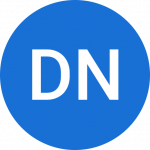
 We'd love your feedback!
We'd love your feedback! Thanks for your feedback!
Thanks for your feedback!

